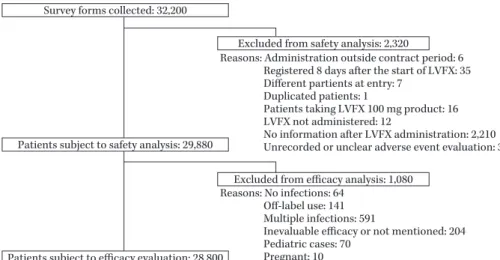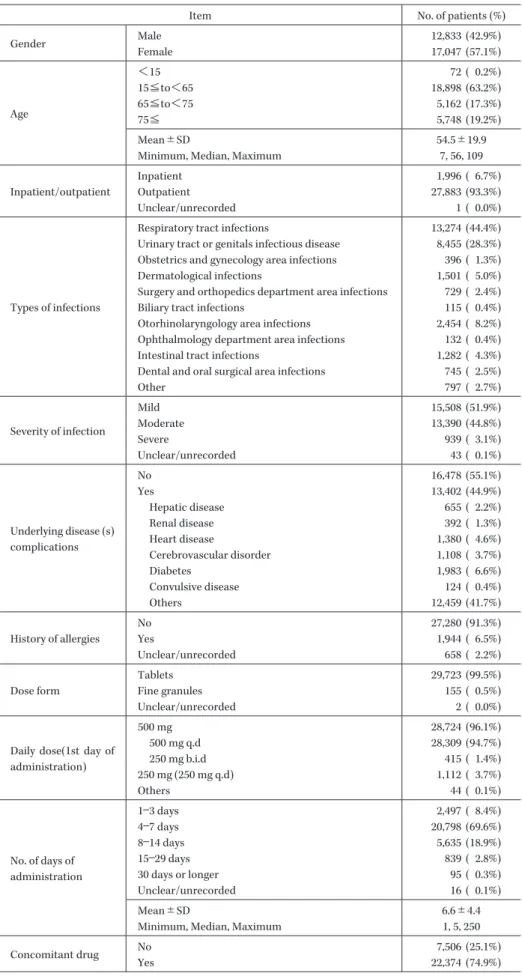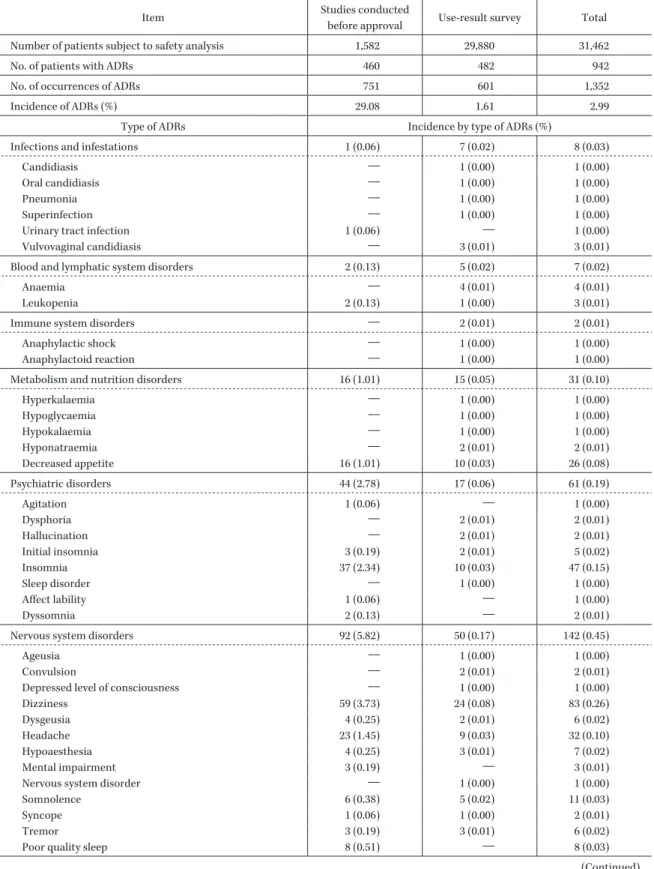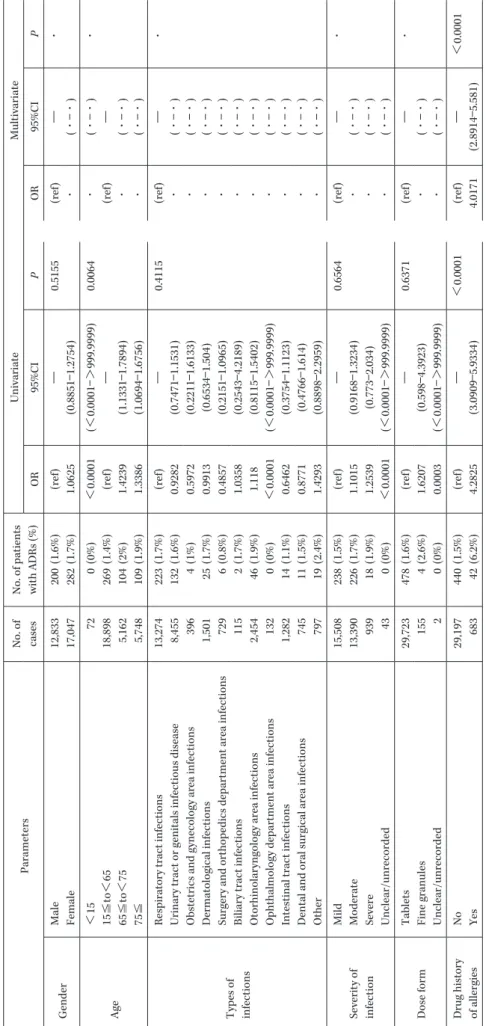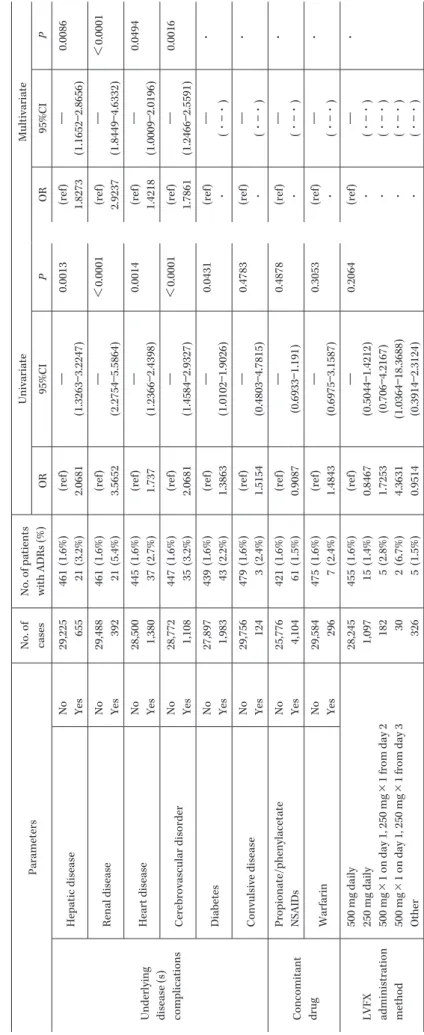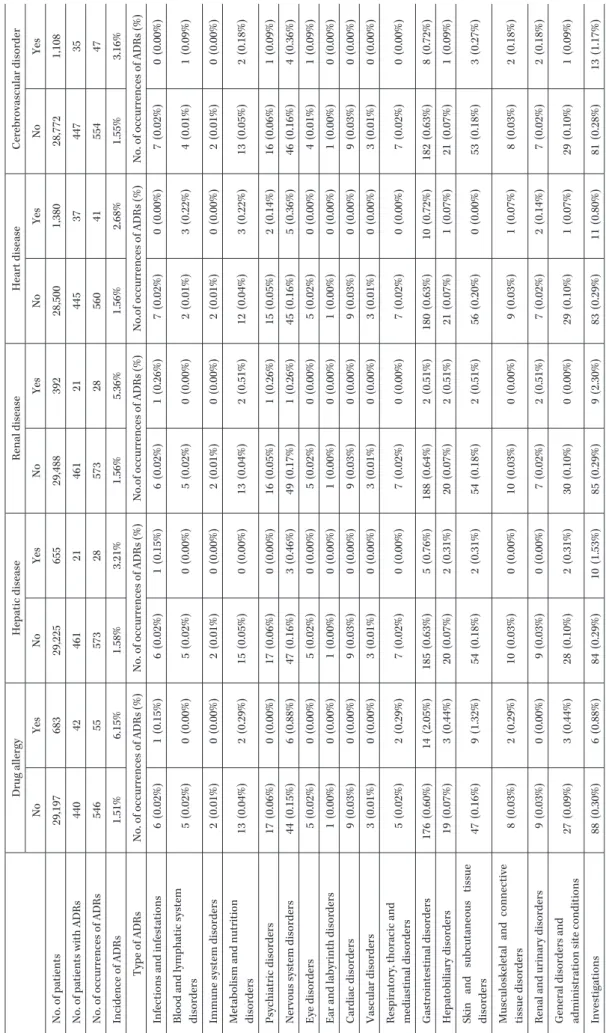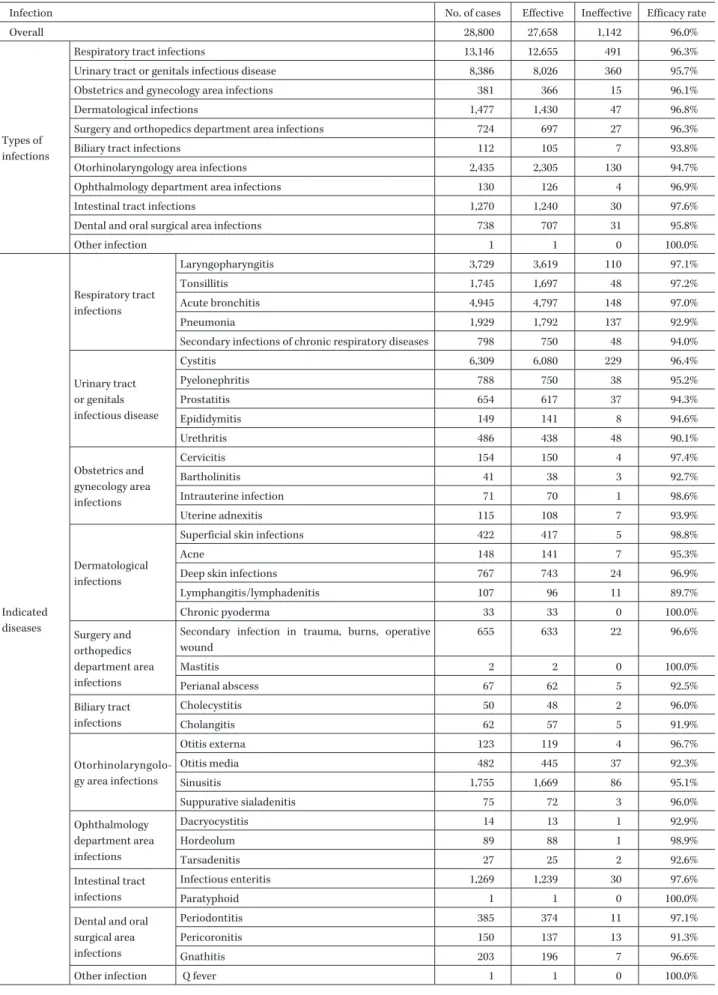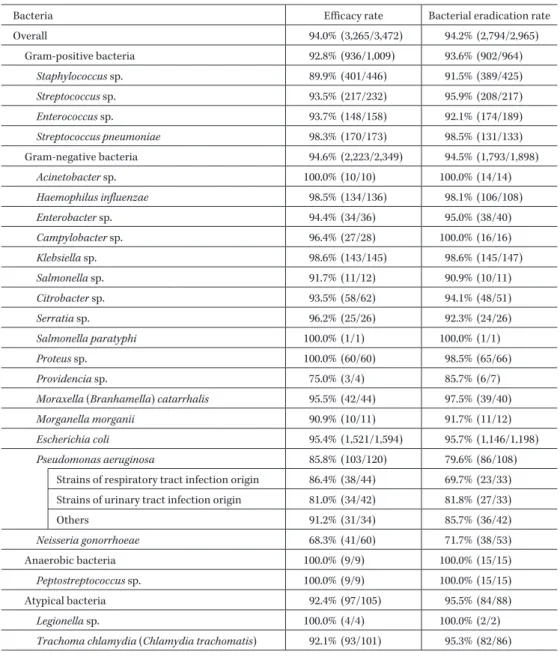【市販後調査報告】
Levofloxacin 500 mg 1 日 1 回投与の安全性・有効性
堀 誠治1)・内納 和浩2)・山口 広貴2)・松本 卓之2)・畔柳 肇子2) 吉田 早苗2)・高橋 周美2)・児玉 浩子2)・濱島 里子2)・米持 理恵3) 小林 史明4)・山之内直樹4)・鈴木 正道3)・塩澤 友男2)・山口 文恵2) 1)東京慈恵会医科大学感染制御科* 2)第一三共株式会社学術調査部 3)同 安全性情報部 4)同 データサイエンス部 (平成 23 年 7 月 28 日受付・平成 23 年 8 月 29 日受理) Levofloxacin(LVFX)は 2009 年 4 月に PK-PD 理論に基づく投与法として 500 mg 1 日 1 回投与が承 認され,2009 年 10 月から 2010 年 9 月にかけて LVFX 錠・細粒 500 mg 1 日 1 回投与による使用成績調 査を実施した。全国 4,547 施設の医療機関から 32,200 例の調査票を収集し,安全性は 29,880 例,有効性 は 28,800 例で検討した。 副作用発現率は 1.61% であり,主な副作用は下痢,悪心等の胃腸障害 0.64%,AST 増加,ALT 増加等 の臨床検査値異常 0.31%,発疹,薬疹等の皮膚および皮下組織障害 0.19%,浮動性めまい等の神経系障害 0.17% で,副作用の種類,発現頻度は LVFX 1 回 100 mg 1 日 2∼3 回投与時と大きく変わるものではな かった。 本薬剤と併用注意となっているフェニル酢酸系・プロピオン酸系非ステロイド性抗炎症薬は 13.7% で併用されたが,併用による中枢神経系副作用発現率の上昇は認められなかった。 腎機能低下患者(Ccr<50 mL!min)において,添付文書に示されている用法・用量で調節した場合, 用量依存的と考えられる中枢神経系副作用は認められなかったが,用法・用量を調節せず,500 mg 1 日 1 回連日投与されていた症例に,痙攣等の中枢神経系副作用が認められた。また,用法・用量を調節 した場合でも 85% を超える有効率を確保していた。 有効率は全体で 96.0% であり, 感染症領域別には, 呼吸器感染症 96.3%, 尿路・性器感染症 95.7%, 耳鼻科領域 94.7%,皮膚科領域 96.8%,腸管感染症 97.6%,外科・整形外科領域 96.3%,産婦人科領域 96.1%,歯科・口腔外科領域 95.8%,胆道感染症 93.8%,眼科領域 96.9% であった。 以上より,LVFX 500 mg 1 日 1 回投与の安全性は,LVFX 1 回 100 mg 1 日 2∼3 回投与と同程度であ り,有効性は,全体で 96.0%,各感染症領域においてもいずれも 90% 以上の有効率であった。さらに腎 機能障害を有する患者では,添付文書に示された腎機能に応じた用法・用量の調節の妥当性が安全性, 有効性から確認された。Key words: levofloxacin,safety,efficacy,postmarketing surveillance
Levofloxacin(LVFX)は,幅広い抗菌スペクトラムならび に優れた抗菌力と安全性を有したキノロン系薬であり,日本 では 100 mg 1 日 2∼3 回(重症または効果不十分と思われる 場合には 1 回 200 mg,1 日 3 回まで増量可能)を標準用量と して,1993 年に錠剤,細粒剤が発売され,呼吸器感染症や泌 尿器領域感染症等,各科領域感染症に広く使用されてきた。 近年,抗菌薬の広汎な使用により各種抗菌薬に対する耐性 菌が出現し,選択できる抗菌薬が狭まりつつあるなかで, LVFX は,肺炎球菌,インフルエンザ菌等の菌に対して 90% 以上の高い感性率を保持しており1∼5) ,有効性と安全性のバラ ンスの優れた抗菌薬として 15 年以上にわたって医療現場で 使用されてきた。一方で,キノロン系薬に対して耐性化を示す 菌の報告4∼6)も散見されている。これら耐性菌の増加を防ぐた めに,Pharmacokinetics-Pharmacodynamics(PK-PD)理論 に 基 づ き,用 法・用 量 の 見 直 し が 行 わ れ,2009 年 4 月 に LVFX の新用法・用量として 500 mg 1 日 1 回投与が承認さ れた。 本薬剤 500 mg 1 日 1 回投与の開発治験7∼9) における日本人 *東京都港区西新橋 3―25―8
Fig. 1. Disposition of subjects.
Reasons: Administration outside contract period: 6 Registered 8 days after the start of LVFX: 35 Different partients at entry: 7
Duplicated patients: 1
Patients taking LVFX 100 mg product: 16 LVFX not administered: 12
No information after LVFX administration: 2,210 Unrecorded or unclear adverse event evaluation: 33 Reasons: No infections: 64
Off-label use: 141 Multiple infections: 591
Inevaluable efficacy or not mentioned: 204 Pediatric cases: 70
Pregnant: 10 Survey forms collected: 32,200
Excluded from safety analysis: 2,320
Patients subject to safety analysis: 29,880
Excluded from efficacy analysis: 1,080
Patients subject to efficacy evaluation: 28,800
の検討症例数は 337 例と限られており,また,適応を有する 43 の疾患のうち,開発治験で検討された疾患は呼吸器領域 (急性気管支炎,肺炎,慢性呼吸器疾患の二次感染)と泌尿器 領域(膀胱炎,腎盂腎炎)の 2 領域,5 疾患であった。したがっ て,市販後,日本人における本薬剤の安全性ならびに有効性を 早期に把握し,医療現場に情報提供することはきわめて重要 と考えた。 今回,2009 年 10 月から 2010 年 9 月にかけて,LVFX 500 mg 1 日 1 回投与の安全性と有効性を検討することを目的と した使用成績調査を実施したので,その成績を報告する。 なお,本調査は「医薬品の製造販売後の調査及び試験の実施 の基準に関する省令」(平成 16 年 12 月 20 日厚生労働省令第 171 号)に則り実施した。 I. 対 象 と 方 法 1.使用薬剤 クラビットⓇ 錠 250 mg(1 錠中に LVFX を 250 mg 含 有するフィルムコーティング錠) クラビットⓇ 錠 500 mg(1 錠中に LVFX を 500 mg 含 有するフィルムコーティング錠) クラビットⓇ 細粒 10%(1 g 中に LVFX を 100 mg 含有 するコーティング細粒) 2.調査対象 本薬剤を投与した患者とし,一度調査対象とした患者 は,繰り返し対象としないこととした。 3.調査方法 中央登録方式にて実施した。 担当医師は,対象となる患者に対して次の事項につい て説明を行うこととした。 1)本薬剤の有効性ならびに安全性を確認するため,可 能な限り,本薬剤服用後に再受診すること。 2)再受診できない場合は,「患者アンケート用紙」に 以下の項目を記入し,担当医師まで郵送すること。 ①今回の感染症の症状が治癒したか否か。 ②本薬剤服用後,何か好ましくない症状が新たに現わ れたか否か。好ましくない症状が新たに現われた場 合は,その詳細を担当医師まで連絡すること。 登録は,本薬剤投与開始後,投与開始日を含めて 7 日 以内に登録票を登録センターに FAX することとした。 登録された症例に関しては,担当医師が調査票を記入し, 投与終了後に調査票を提出した。 4.調査期間および調査予定例数 調査期間は 2009 年 10 月 1 日∼2010 年 9 月 30 日(登 録期間:2009 年 10 月 1 日∼2010 年 9 月 17 日)とし,調 査予定例数は 30,000 例とした。 5.調査項目 調査項目は,患者背景(性別,年齢,入院・外来の区 分,体重,感染症名,感染症の重症度,基礎疾患・合併 症,アレルギー歴等),薬剤投与状況(本薬剤の 1 回投与 量,1 日投与回数,投与期間,併用薬剤等),細菌学的検 査,臨床検査,有効性評価,有害事象とした。 6.評価指標 1) 安全性 安全性については,本薬剤との関連性の有無にかかわ らず,本薬剤投与後に発現したすべての有害事象(疾患, 症状,臨床検査値異常等)について担当医師が問診,患 者アンケート用紙等よりその有無を確認し,有害事象 「有」の場合は,発現日,重篤性,転帰,本薬剤との関連 性等を調査した。有害事象のうち,本薬剤との関連性が 否定できない事象を副作用とした。副作用発現率は(副 作用発現症例数!安全性解析対象例数)×100(%)として 算出した。副作用の集計には「ICH 国際医薬用語集日本 版(MedDRA!J:Medical Dictionary for Regulatory
Ac-tivities!J」(Ver. 13.1)を用いた。
2) 有効性
有効性については,本薬剤の投与中止・終了時の臨床 効果を臨床症状,検査結果,患者アンケート用紙等から
Table 1. Patients profiles in safety analysis
Item No. of patients (%)
Gender Male 12,833 (42.9%) Female 17,047 (57.1%) Age <15 72 ( 0.2%) 15≦to<65 18,898 (63.2%) 65≦to<75 5,162 (17.3%) 75≦ 5,748 (19.2%) Mean±SD 54.5±19.9
Minimum, Median, Maximum 7, 56, 109
Inpatient/outpatient
Inpatient 1,996 ( 6.7%)
Outpatient 27,883 (93.3%)
Unclear/unrecorded 1 ( 0.0%)
Types of infections
Respiratory tract infections 13,274 (44.4%) Urinary tract or genitals infectious disease 8,455 (28.3%) Obstetrics and gynecology area infections 396 ( 1.3%) Dermatological infections 1,501 ( 5.0%) Surgery and orthopedics department area infections 729 ( 2.4%)
Biliary tract infections 115 ( 0.4%)
Otorhinolaryngology area infections 2,454 ( 8.2%) Ophthalmology department area infections 132 ( 0.4%) Intestinal tract infections 1,282 ( 4.3%) Dental and oral surgical area infections 745 ( 2.5%)
Other 797 ( 2.7%) Severity of infection Mild 15,508 (51.9%) Moderate 13,390 (44.8%) Severe 939 ( 3.1%) Unclear/unrecorded 43 ( 0.1%) Underlying disease (s) complications No 16,478 (55.1%) Yes 13,402 (44.9%) Hepatic disease 655 ( 2.2%) Renal disease 392 ( 1.3%) Heart disease 1,380 ( 4.6%) Cerebrovascular disorder 1,108 ( 3.7%) Diabetes 1,983 ( 6.6%) Convulsive disease 124 ( 0.4%) Others 12,459 (41.7%) History of allergies No 27,280 (91.3%) Yes 1,944 ( 6.5%) Unclear/unrecorded 658 ( 2.2%) Dose form Tablets 29,723 (99.5%) Fine granules 155 ( 0.5%) Unclear/unrecorded 2 ( 0.0%)
Daily dose(1st day of administration) 500 mg 28,724 (96.1%) 500 mg q.d 28,309 (94.7%) 250 mg b.i.d 415 ( 1.4%) 250 mg (250 mg q.d) 1,112 ( 3.7%) Others 44 ( 0.1%) No. of days of administration 1―3 days 2,497 ( 8.4%) 4―7 days 20,798 (69.6%) 8―14 days 5,635 (18.9%) 15―29 days 839 ( 2.8%) 30 days or longer 95 ( 0.3%) Unclear/unrecorded 16 ( 0.1%) Mean±SD 6.6±4.4
Minimum, Median, Maximum 1, 5, 250
Concomitant drug No 7,506 (25.1%)
Table 2. Incidence of adverse drug reactions
Item Studies conducted
before approval Use-result survey Total Number of patients subject to safety analysis 1,582 29,880 31,462
No. of patients with ADRs 460 482 942
No. of occurrences of ADRs 751 601 1,352
Incidence of ADRs (%) 29.08 1.61 2.99
Type of ADRs Incidence by type of ADRs (%)
Infections and infestations 1 (0.06) 7 (0.02) 8 (0.03)
Candidiasis ― 1 (0.00) 1 (0.00)
Oral candidiasis ― 1 (0.00) 1 (0.00)
Pneumonia ― 1 (0.00) 1 (0.00)
Superinfection ― 1 (0.00) 1 (0.00)
Urinary tract infection 1 (0.06) ― 1 (0.00)
Vulvovaginal candidiasis ― 3 (0.01) 3 (0.01)
Blood and lymphatic system disorders 2 (0.13) 5 (0.02) 7 (0.02)
Anaemia ― 4 (0.01) 4 (0.01)
Leukopenia 2 (0.13) 1 (0.00) 3 (0.01)
Immune system disorders ― 2 (0.01) 2 (0.01)
Anaphylactic shock ― 1 (0.00) 1 (0.00)
Anaphylactoid reaction ― 1 (0.00) 1 (0.00)
Metabolism and nutrition disorders 16 (1.01) 15 (0.05) 31 (0.10)
Hyperkalaemia ― 1 (0.00) 1 (0.00) Hypoglycaemia ― 1 (0.00) 1 (0.00) Hypokalaemia ― 1 (0.00) 1 (0.00) Hyponatraemia ― 2 (0.01) 2 (0.01) Decreased appetite 16 (1.01) 10 (0.03) 26 (0.08) Psychiatric disorders 44 (2.78) 17 (0.06) 61 (0.19) Agitation 1 (0.06) ― 1 (0.00) Dysphoria ― 2 (0.01) 2 (0.01) Hallucination ― 2 (0.01) 2 (0.01) Initial insomnia 3 (0.19) 2 (0.01) 5 (0.02) Insomnia 37 (2.34) 10 (0.03) 47 (0.15) Sleep disorder ― 1 (0.00) 1 (0.00) Affect lability 1 (0.06) ― 1 (0.00) Dyssomnia 2 (0.13) ― 2 (0.01)
Nervous system disorders 92 (5.82) 50 (0.17) 142 (0.45)
Ageusia ― 1 (0.00) 1 (0.00)
Convulsion ― 2 (0.01) 2 (0.01)
Depressed level of consciousness ― 1 (0.00) 1 (0.00)
Dizziness 59 (3.73) 24 (0.08) 83 (0.26)
Dysgeusia 4 (0.25) 2 (0.01) 6 (0.02)
Headache 23 (1.45) 9 (0.03) 32 (0.10)
Hypoaesthesia 4 (0.25) 3 (0.01) 7 (0.02)
Mental impairment 3 (0.19) ― 3 (0.01)
Nervous system disorder ― 1 (0.00) 1 (0.00)
Somnolence 6 (0.38) 5 (0.02) 11 (0.03)
Syncope 1 (0.06) 1 (0.00) 2 (0.01)
Tremor 3 (0.19) 3 (0.01) 6 (0.02)
Poor quality sleep 8 (0.51) ― 8 (0.03)
(Continued) 担当医師が総合的に判断し,「有効」,「無効」および「判 定不能」で判定した。有効率は(有効症例数!有効性解析 対象症例数)×100(%)として算出した。 菌の消長は,本薬剤投与開始前に担当医師が原因菌と 推定した菌を対象に,本薬剤投与終了・中止時の原因菌 の消長を「消失」,「推定消失」,「存続」,「判定不能」で 判定した。菌消失率は(「消失+推定消失株数」!「消失+ 推定消失+存続」)×100(%)として算出した。
Table 2. (Continued)
Item Studies conducted
before approval Use-result survey Total
Type of ADRs Incidence by type of ADRs (%)
Eye disorders 3 (0.19) 5 (0.02) 8 (0.03) Diplopia ― 1 (0.00) 1 (0.00) Dry eye 1 (0.06) ― 1 (0.00) Eye swelling 1 (0.06) ― 1 (0.00) Eyelid oedema 1 (0.06) ― 1 (0.00) Ocular hyperaemia ― 1 (0.00) 1 (0.00) Vision blurred ― 1 (0.00) 1 (0.00)
Visual acuity reduced ― 1 (0.00) 1 (0.00)
Visual impairment ― 1 (0.00) 1 (0.00)
Ear and labyrinth disorders 3 (0.19) 1 (0.00) 4 (0.01)
Tinnitus 2 (0.13) ― 2 (0.01) Vertigo ― 1 (0.00) 1 (0.00) Ear discomfort 1 (0.06) ― 1 (0.00) Cardiac disorders 10 (0.63) 9 (0.03) 19 (0.06) Bradycardia 1 (0.06) ― 1 (0.00) Palpitations 9 (0.57) 9 (0.03) 18 (0.06) Vascular disorders 2 (0.13) 3 (0.01) 5 (0.02) Flushing ― 1 (0.00) 1 (0.00) Hypertension 1 (0.06) 1 (0.00) 2 (0.01) Hot flush 1 (0.06) 1 (0.00) 2 (0.01)
Respiratory, thoracic and mediastinal disorders 5 (0.32) 7 (0.02) 12 (0.04)
Choking sensation 1 (0.06) ― 1 (0.00)
Dry throat 4 (0.25) ― 4 (0.01)
Dyspnoea ― 3 (0.01) 3 (0.01)
Epistaxis ― 2 (0.01) 2 (0.01)
Interstitial lung disease ― 1 (0.00) 1 (0.00)
Rhinorrhoea ― 1 (0.00) 1 (0.00)
Gastrointestinal disorders 139 (8.79) 190 (0.64) 329 (1.05)
Abdominal discomfort 20 (1.26) 24 (0.08) 44 (0.14)
Abdominal distension 12 (0.76) 3 (0.01) 15 (0.05)
Abdominal pain 6 (0.38) 5 (0.02) 11 (0.03)
Abdominal pain lower 1 (0.06) 1 (0.00) 2 (0.01)
Abdominal pain upper 8 (0.51) 12 (0.04) 20 (0.06)
Constipation 4 (0.25) 9 (0.03) 13 (0.04)
Diarrhoea 22 (1.39) 73 (0.24) 95 (0.30)
Dry mouth 11 (0.70) ― 11 (0.03)
Dyspepsia 5 (0.32) 3 (0.01) 8 (0.03)
Eructation 2 (0.13) ― 2 (0.01)
Frequent bowel movements 1 (0.06) ― 1 (0.00)
Gastritis ― 3 (0.01) 3 (0.01)
Gastrooesophageal reflux disease 3 (0.19) ― 3 (0.01)
Gastrointestinal disorder 6 (0.38) 5 (0.02) 11 (0.03) Glossitis ― 1 (0.00) 1 (0.00) Mouth ulceration ― 1 (0.00) 1 (0.00) Nausea 55 (3.48) 51 (0.17) 106 (0.34) Stomatitis ― 2 (0.01) 2 (0.01) Vomiting 22 (1.39) 16 (0.05) 38 (0.12) Tongue dry 1 (0.06) ― 1 (0.00) Epigastric discomfort 1 (0.06) 1 (0.00) 2 (0.01) Hypoaesthesia oral ― 1 (0.00) 1 (0.00) Hepatobiliary disorders 16 (1.01) 22 (0.07) 38 (0.12)
Hepatic function abnormal 15 (0.95) 14 (0.05) 29 (0.09)
Liver disorder 1 (0.06) 8 (0.03) 9 (0.03)
Table 2. (Continued)
Item Studies conducted
before approval Use-result survey Total
Type of ADRs Incidence by type of ADRs (%)
Skin and subcutaneous tissue disorders 24 (1.52) 56 (0.19) 80 (0.25)
Cold sweat ― 2 (0.01) 2 (0.01) Drug eruption 2 (0.13) 16 (0.05) 18 (0.06) Eczema ― 3 (0.01) 3 (0.01) Erythema 1 (0.06) 3 (0.01) 4 (0.01) Hyperhidrosis 1 (0.06) ― 1 (0.00) Photosensitivity reaction ― 1 (0.00) 1 (0.00) Pruritus 8 (0.51) 4 (0.01) 12 (0.04) Rash 13 (0.82) 19 (0.06) 32 (0.10) Rash generalised 1 (0.06) 1 (0.00) 2 (0.01) Rash pruritic ― 1 (0.00) 1 (0.00) Urticaria ― 10 (0.03) 10 (0.03) Pruritus generalised ― 2 (0.01) 2 (0.01)
Musculoskeletal and connective tissue disorders 13 (0.82) 10 (0.03) 23 (0.07)
Arthralgia 3 (0.19) 2 (0.01) 5 (0.02) Back pain 2 (0.13) 1 (0.00) 3 (0.01) Flank pain ― 1 (0.00) 1 (0.00) Joint swelling 1 (0.06) ― 1 (0.00) Muscular weakness 2 (0.13) 1 (0.00) 3 (0.01) Musculoskeletal pain 1 (0.06) ― 1 (0.00) Myalgia ― 3 (0.01) 3 (0.01) Pain in extremity 4 (0.25) ― 4 (0.01) Tendon disorder ― 1 (0.00) 1 (0.00) Tendon pain ― 1 (0.00) 1 (0.00)
Renal and urinary disorders 4 (0.25) 9 (0.03) 13 (0.04)
Haematuria 1 (0.06) ― 1 (0.00) Oliguria 1 (0.06) ― 1 (0.00) Pollakiuria 1 (0.06) 2 (0.01) 3 (0.01) Proteinuria ― 1 (0.00) 1 (0.00) Renal disorder ― 1 (0.00) 1 (0.00) Urine abnormality ― 1 (0.00) 1 (0.00) Renal impairment 1 (0.06) 4 (0.01) 5 (0.02)
Reproductive system and breast disorders 1 (0.06) ― 1 (0.00)
Menstrual disorder 1 (0.06) ― 1 (0.00)
General disorders and administration site conditions 27 (1.71) 30 (0.10) 57 (0.18)
Asthenia 12 (0.76) 3 (0.01) 15 (0.05) Chest discomfort 6 (0.38) ― 6 (0.02) Chills 1 (0.06) ― 1 (0.00) Death ― 1 (0.00) 1 (0.00) Face oedema ― 3 (0.01) 3 (0.01) Fatigue 1 (0.06) ― 1 (0.00) Feeling abnormal 3 (0.19) 5 (0.02) 8 (0.03) Feeling hot 1 (0.06) ― 1 (0.00) Irritability ― 1 (0.00) 1 (0.00) Malaise 1 (0.06) 8 (0.03) 9 (0.03) Oedema ― 1 (0.00) 1 (0.00) Oedema peripheral 2 (0.13) 3 (0.01) 5 (0.02) Pyrexia ― 1 (0.00) 1 (0.00) Thirst 1 (0.06) 6 (0.02) 7 (0.02) Localised oedema ― 1 (0.00) 1 (0.00) (Continued) 7.統計解析方法 安全性に影響を及ぼす要因を検討するため要因別の副 作用発現率を算出し,要因ごとの副作用発現率の一様性 についてχ2検定を行った。 検定の際には「不明」は除き, 有意水準は両側 5% とした。さらに,一様性のχ2 検定の 結果が有意であった要因を対象に多変量の検討を行っ
Table 2. (Continued)
Item Studies conducted
before approval Use-result survey Total
Type of ADRs Incidence by type of ADRs (%)
Investigations 211 (13.34) 94 (0.31) 305 (0.97)
Alanine aminotransferase increased 29 (1.83) 26 (0.09) 55 (0.17) Aspartate aminotransferase increased 22 (1.39) 26 (0.09) 48 (0.15)
Basophil count increased 1 (0.06) ― 1 (0.00)
Blood bilirubin increased 10 (0.63) ― 10 (0.03)
Blood chloride decreased ― 1 (0.00) 1 (0.00)
Blood creatine phosphokinase increased 4 (0.25) 5 (0.02) 9 (0.03)
Blood creatinine increased 3 (0.19) 8 (0.03) 11 (0.03)
Blood glucose decreased 1 (0.06) 1 (0.00) 2 (0.01)
Blood glucose increased ― 1 (0.00) 1 (0.00)
Blood lactate dehydrogenase increased 26 (1.64) 6 (0.02) 32 (0.10)
Blood potassium increased 2 (0.13) 2 (0.01) 4 (0.01)
Blood pressure increased ― 1 (0.00) 1 (0.00)
Blood urea decreased 1 (0.06) ― 1 (0.00)
Blood urea increased 1 (0.06) 3 (0.01) 4 (0.01)
C-reactive protein increased ― 1 (0.00) 1 (0.00)
Blood uric acid increased 1 (0.06) ― 1 (0.00)
Eosinophil count decreased 3 (0.19) ― 3 (0.01)
Eosinophil count increased 19 (1.20) 10 (0.03) 29 (0.09)
Gamma-glutamyltransferase abnormal 1 (0.06) ― 1 (0.00)
Gamma-glutamyltransferase increased 10 (0.63) 8 (0.03) 18 (0.06)
Glucose urine present 3 (0.19) 1 (0.00) 4 (0.01)
Hematocrit decreased 2 (0.13) ― 2 (0.01)
Hematocrit increased 1 (0.06) ― 1 (0.00)
Blood urine present 3 (0.19) ― 3 (0.01)
Hemoglobin decreased ― 1 (0.00) 1 (0.00)
Hemoglobin increased 1 (0.06) ― 1 (0.00)
Liver function test abnormal ― 3 (0.01) 3 (0.01)
Lymphocyte count decreased 2 (0.13) ― 2 (0.01)
Lymphocyte count increased 4 (0.25) ― 4 (0.01)
Monocyte count increased 2 (0.13) ― 2 (0.01)
Neutrophil count decreased 13 (0.82) 1 (0.00) 14 (0.04)
Platelet count decreased 18 (1.14) 3 (0.01) 21 (0.07)
Red blood cell count decreased 2 (0.13) ― 2 (0.01)
White blood cell count decreased 50 (3.16) 4 (0.01) 54 (0.17)
White blood cell count increased 3 (0.19) 2 (0.01) 5 (0.02)
Blood bilirubin decreased 1 (0.06) ― 1 (0.00)
Platelet count increased 15 (0.95) 2 (0.01) 17 (0.05)
Basophil percentage increased 3 (0.19) ― 3 (0.01)
Eosinophil percentage increased 3 (0.19) 6 (0.02) 9 (0.03)
Neutrophil percentage decreased 5 (0.32) ― 5 (0.02)
Neutrophil percentage increased 1 (0.06) ― 1 (0.00)
Monocyte percentage increased 2 (0.13) ― 2 (0.01)
Lymphocyte percentage decreased 1 (0.06) 1 (0.00) 2 (0.01)
Lymphocyte percentage increased 8 (0.51) ― 8 (0.03)
Protein urine present 4 (0.25) 1 (0.00) 5 (0.02)
Blood alkaline phosphatase increased 5 (0.32) 6 (0.02) 11 (0.03)
Hepatic enzyme increased ― 1 (0.00) 1 (0.00)
た。変数増減法(基準:P=0.05)を用いたロジスティッ ク回帰分析を行い,選択された要因についてオッズ比と その 95% 信頼区間を算出した。 II. 結 果 1.症例構成 全国 4,547 施設(医院 3,950 施設,病院 597 施設)の医 療機関から 32,200 例の調査票が収集された。各解析対象 の内訳を Fig. 1 に示す。 32,200 例のうち,本薬剤未投与症例,本薬剤投与開始日 以降の情報がない症例等の計 2,320 例を除いた 29,880 例 を安全性解析症例とした。 安全性解析対象症例 29,880 例のうち, 非感染症症例,
Table
3.
Incidence of adverse drug reactions by patients profile
Parameters
No. of cases No. of patients with ADRs (%)
Univariate Multivariate OR 95%CI P OR 95%CI P Gender Male 12,833 200 (1.6%) (ref) ― 0.5155 (ref) ―・ Female 17,047 282 (1.7%) 1.0625 (0.8851 ― 1.2754) ・ (・ ―・ ) Age < 15 72 0 (0%) < 0.0001 (< 0.0001 ―> 999.9999) 0.0064 ・ (・ ―・ ) ・ 15 ≦ to < 65 18,898 269 (1.4%) (ref) ― (ref) ― 65 ≦ to < 75 5,162 104 (2%) 1.4239 (1.1331 ― 1.7894) ・ (・ ―・ ) 75 ≦ 5,748 109 (1.9%) 1.3386 (1.0694 ― 1.6756) ・ (・ ―・ ) Types of infections
Respiratory tract infections
13,274 223 (1.7%) (ref) ― 0.4115 (ref) ―・
Urinary tract or genitals infectious disease
8,455 132 (1.6%) 0.9282 (0.7471 ― 1.1531) ・ (・ ―・ )
Obstetrics and gynecology area infections
396 4 (1%) 0.5972 (0.2211 ― 1.6133) ・ (・ ―・ ) Dermatological infections 1,501 25 (1.7%) 0.9913 (0.6534 ― 1.504) ・ (・ ―・ )
Surgery and orthopedics department area infections
729 6 (0.8%) 0.4857 (0.2151 ― 1.0965) ・ (・ ―・ )
Biliary tract infections
115 2 (1.7%) 1.0358 (0.2543 ― 4.2189) ・ (・ ―・ )
Otorhinolaryngology area infections
2,454 46 (1.9%) 1.118 (0.8115 ― 1.5402) ・ (・ ―・ )
Ophthalmology department area infections
132 0 (0%) < 0.0001 (< 0.0001 ―> 999.9999) ・ (・ ―・ )
Intestinal tract infections
1,282 14 (1.1%) 0.6462 (0.3754 ― 1.1123) ・ (・ ―・ )
Dental and oral surgical area infections
745 11 (1.5%) 0.8771 (0.4766 ― 1.614) ・ (・ ―・ ) Other 797 19 (2.4%) 1.4293 (0.8898 ― 2.2959) ・ (・ ―・ ) Severity of infection Mild 15,508 238 (1.5%) (ref) ― 0.6564 (ref) ―・ Moderate 13,390 226 (1.7%) 1.1015 (0.9168 ― 1.3234) ・ (・ ―・ ) Severe 939 18 (1.9%) 1.2539 (0.773 ― 2.034) ・ (・ ―・ ) Unclear/unrecorded 43 0 (0%) < 0.0001 (< 0.0001 ―> 999.9999) ・ (・ ―・ ) Dose form Tablets 29,723 478 (1.6%) (ref) ― 0.6371 (ref) ―・ Fine granules 155 4 (2.6%) 1.6207 (0.598 ― 4.3923) ・ (・ ―・ ) Unclear/unrecorded 2 0 (0%) 0.0003 (< 0.0001 ―> 999.9999) ・ (・ ―・ )
Drug history of allergies
No 29,197 440 (1.5%) (ref) ―< 0.0001 (ref) ―< 0.0001 Yes 683 42 (6.2%) 4.2825 (3.0909 ― 5.9334) 4.0171 (2.8914 ― 5.581) (Continued)
Table 3. (Continued) Parameters No. of cases No. of patients with ADRs (%)
Univariate Multivariate OR 95%CI P OR 95%CI P
Underlying disease (s) complications
Hepatic disease No 29,225 461 (1.6%) (ref) ― 0.0013 (ref) ― 0.0086 Yes 655 21 (3.2%) 2.0681 (1.3263 ― 3.2247) 1.8273 (1.1652 ― 2.8656) Renal disease No 29,488 461 (1.6%) (ref) ―< 0.0001 (ref) ―< 0.0001 Yes 392 21 (5.4%) 3.5652 (2.2754 ― 5.5864) 2.9237 (1.8449 ― 4.6332) Heart disease No 28,500 445 (1.6%) (ref) ― 0.0014 (ref) ― 0.0494 Yes 1,380 37 (2.7%) 1.737 (1.2366 ― 2.4398) 1.4218 (1.0009 ― 2.0196) Cerebrovascular disorder No 28,772 447 (1.6%) (ref) ―< 0.0001 (ref) ― 0.0016 Yes 1,108 35 (3.2%) 2.0681 (1.4584 ― 2.9327) 1.7861 (1.2466 ― 2.5591) Diabetes No 27,897 439 (1.6%) (ref) ― 0.0431 (ref) ―・ Yes 1,983 43 (2.2%) 1.3863 (1.0102 ― 1.9026) ・ (・ ―・ ) Convulsive disease No 29,756 479 (1.6%) (ref) ― 0.4783 (ref) ―・ Yes 124 3 (2.4%) 1.5154 (0.4803 ― 4.7815) ・ (・ ―・ ) Concomitant drug Propionate/phenylacetate NSAIDs No 25,776 421 (1.6%) (ref) ― 0.4878 (ref) ―・ Yes 4,104 61 (1.5%) 0.9087 (0.6933 ― 1.191) ・ (・ ―・ ) Warfarin No 29,584 475 (1.6%) (ref) ― 0.3053 (ref) ―・ Yes 296 7 (2.4%) 1.4843 (0.6975 ― 3.1587) ・ (・ ―・ ) LVFX administration method 500 mg daily 28,245 455 (1.6%) (ref) ― 0.2064 (ref) ―・ 250 mg daily 1,097 15 (1.4%) 0.8467 (0.5044 ― 1.4212) ・ (・ ―・ ) 500 mg × 1 on day 1, 250 mg × 1 from day 2 182 5 (2.8%) 1.7253 (0.706 ― 4.2167) ・ (・ ―・ ) 500 mg × 1 on day 1, 250 mg × 1 from day 3 30 2 (6.7%) 4.3631 (1.0364 ― 18.3688) ・ (・ ―・ ) Other 326 5 (1.5%) 0.9514 (0.3914 ― 2.3124) ・ (・ ―・ )
Table
4.
Incidence of ADRs by presence/absence of drug allergy, hepatic disease, renal disease, heart disease, cerebrovascular disorder Drug allergy
Hepatic disease Renal disease Heart disease Cerebrovascular disorder No Yes No Yes No Yes No Yes No Yes No. of patients 29,197 683 29,225 655 29,488 392 28,500 1,380 28,772 1,108
No. of patients with ADRs
440 42 461 21 461 21 445 37 447 35
No. of occurrences of ADRs
546 55 573 28 573 28 560 41 554 47 Incidence of ADRs 1.51% 6.15% 1.58% 3.21% 1.56% 5.36% 1.56% 2.68% 1.55% 3.16% Type of ADRs
No. of occurrences of ADRs (%)
No. of occurrences of ADRs (%)
No.of occurrences of ADRs (%)
No.of occurrences of ADRs
(%)
No. of occurrences of ADRs (%)
Infections and infestations
6 (0.02%) 1 (0.15%) 6 (0.02%) 1 (0.15%) 6 (0.02%) 1 (0.26%) 7 (0.02%) 0 (0.00%) 7 (0.02%) 0 (0.00%)
Blood and lymphatic system disorders
5 (0.02%) 0 (0.00%) 5 (0.02%) 0 (0.00%) 5 (0.02%) 0 (0.00%) 2 (0.01%) 3 (0.22%) 4 (0.01%) 1 (0.09%)
Immune system disorders
2 (0.01%) 0 (0.00%) 2 (0.01%) 0 (0.00%) 2 (0.01%) 0 (0.00%) 2 (0.01%) 0 (0.00%) 2 (0.01%) 0 (0.00%)
Metabolism and nutrition disorders
13 (0.04%) 2 (0.29%) 15 (0.05%) 0 (0.00%) 13 (0.04%) 2 (0.51%) 12 (0.04%) 3 (0.22%) 13 (0.05%) 2 (0.18%) Psychiatric disorders 17 (0.06%) 0 (0.00%) 17 (0.06%) 0 (0.00%) 16 (0.05%) 1 (0.26%) 15 (0.05%) 2 (0.14%) 16 (0.06%) 1 (0.09%)
Nervous system disorders
44 (0.15%) 6 (0.88%) 47 (0.16%) 3 (0.46%) 49 (0.17%) 1 (0.26%) 45 (0.16%) 5 (0.36%) 46 (0.16%) 4 (0.36%) Eye disorders 5 (0.02%) 0 (0.00%) 5 (0.02%) 0 (0.00%) 5 (0.02%) 0 (0.00%) 5 (0.02%) 0 (0.00%) 4 (0.01%) 1 (0.09%)
Ear and labyrinth disorders
1 (0.00%) 0 (0.00%) 1 (0.00%) 0 (0.00%) 1 (0.00%) 0 (0.00%) 1 (0.00%) 0 (0.00%) 1 (0.00%) 0 (0.00%) Cardiac disorders 9 (0.03%) 0 (0.00%) 9 (0.03%) 0 (0.00%) 9 (0.03%) 0 (0.00%) 9 (0.03%) 0 (0.00%) 9 (0.03%) 0 (0.00%) Vascular disorders 3 (0.01%) 0 (0.00%) 3 (0.01%) 0 (0.00%) 3 (0.01%) 0 (0.00%) 3 (0.01%) 0 (0.00%) 3 (0.01%) 0 (0.00%)
Respiratory, thoracic and mediastinal disorders
5 (0.02%) 2 (0.29%) 7 (0.02%) 0 (0.00%) 7 (0.02%) 0 (0.00%) 7 (0.02%) 0 (0.00%) 7 (0.02%) 0 (0.00%) Gastrointestinal disorders 176 (0.60%) 14 (2.05%) 185 (0.63%) 5 (0.76%) 188 (0.64%) 2 (0.51%) 180 (0.63%) 10 (0.72%) 182 (0.63%) 8 (0.72%) Hepatobiliary disorders 19 (0.07%) 3 (0.44%) 20 (0.07%) 2 (0.31%) 20 (0.07%) 2 (0.51%) 21 (0.07%) 1 (0.07%) 21 (0.07%) 1 (0.09%)
Skin and subcutaneous tissue disorders
47 (0.16%) 9 (1.32%) 54 (0.18%) 2 (0.31%) 54 (0.18%) 2 (0.51%) 56 (0.20%) 0 (0.00%) 53 (0.18%) 3 (0.27%)
Musculoskeletal and connective tissue disorders
8 (0.03%) 2 (0.29%) 10 (0.03%) 0 (0.00%) 10 (0.03%) 0 (0.00%) 9 (0.03%) 1 (0.07%) 8 (0.03%) 2 (0.18%)
Renal and urinary disorders
9 (0.03%) 0 (0.00%) 9 (0.03%) 0 (0.00%) 7 (0.02%) 2 (0.51%) 7 (0.02%) 2 (0.14%) 7 (0.02%) 2 (0.18%)
General disorders and administration site conditions
27 (0.09%) 3 (0.44%) 28 (0.10%) 2 (0.31%) 30 (0.10%) 0 (0.00%) 29 (0.10%) 1 (0.07%) 29 (0.10%) 1 (0.09%) Investigations 88 (0.30%) 6 (0.88%) 84 (0.29%) 10 (1.53%) 85 (0.29%) 9 (2.30%) 83 (0.29%) 11 (0.80%) 81 (0.28%) 13 (1.17%)
Table 5. Incidence of ADRs by presence/absence of NSAIDs No concomitant NSAIDs (N=21,826) Concomitant use of propionate/phenylacetate NSAIDs (N=4,104)
Concomitant use of other
NSAIDs (N=3,950) χ2test
No. of patients with ADRs (%) 323 (1.48) 61 (1.49) 98 (2.48) P<0.0001
No. of patients with CNS ADRs (%) 46 (0.21) 9 (0.22) 10 (0.25) P=0.8703
適応外の感染症に本薬剤を投与した症例等の計 1,080 例 を除く 28,800 例を有効性解析対象症例とした。 2.患者背景 安全性解析対象症例の患者背景を Table 1 に示す。 平均年齢は 54.5±19.9 歳(平均±SD)であり,36.5% が 65 歳以上の高齢者,19.2% が 75 歳以上の後期高齢者 であった。入院・外来別では,93.3% が外来の症例で,感 染症領域別では,呼吸器感染症が 44.4% と最も多く,次 いで尿路・性器感染症が 28.3% とこの 2 領域で全体の 7 割を超えていた。感染症の重症度は,軽症が 51.9%,中等 症が 44.8%,重症が 3.1% であった。基礎疾患・合併症を 有する症例は 44.9% であり,肝疾患,腎疾患,糖尿病合 併例がおのおの 2.2%,1.3%,6.6% であった。アレルギー 歴は 6.5% の症例が有していた。 本薬剤の 1 日投与量は 500 mg 1 日 1 回投与が 94.7% で,その他,250 mg 1 日 2 回投与が 1.4%,250 mg 1 日 1 回投与が 3.7% であった。投与期間は 6.6±4.4 日(平 均±SD)であった。併用薬は 74.9% の症例で使用されて いた。 3.安全性 1) 副作用発現状況 安全性解析対象症例 29,880 例中,副作用は 482 例(601 件)に認められ,副作用発現率は 1.61%(482 例!29,880 例)であった。主な副作用は下痢,悪心等の胃腸障害が 190 例(0.64%),AST 増加,ALT 増加等の臨床検査値異 常が 94 例(0.31%),発疹,薬疹等の皮膚および皮下組織 障害が 56 例(0.19%),浮動性めまい等の神経系障害が 50 例(0.17%)であった(Table 2)。 重篤な副作用は,アナフィラキシーショック,不眠症, 痙攣,失神,肝障害,腎機能障害,死亡,血小板数減少, 肺炎が各 1 例(各 1 件),肝機能異常が 2 例(2 件)の計 11 例(11 件)であった。そのうち,アナフィラキシー ショック,不眠症,痙攣,失神,肝機能異常,腎機能障 害,血小板数減少の 7 例(7 件)では本薬剤投与中止後, 軽快あるいは回復していた。肺炎,肝機能異常の 2 例(2 件)は未回復,肝障害の 1 例(1 件)の転帰は不明であっ た。また,死亡は本薬剤処方後,当日の入浴中に死亡が 確認された症例であり,死因等の詳細は不明であった。 2) 安全性に影響を与える要因 安全性に影響を与える要因を検討するため,「性別」, 「年齢」,「感染症領域」,「剤型」,「基礎疾患・合併症(肝 疾患,腎疾患,心疾患,脳血管障害,糖尿病,痙攣性疾 患の有無)」等と,副作用発現率との関連を検討した。ロ ジスティック回帰分析の結果,有意差が認められた要因 は「薬剤アレルギー歴の有無」,「肝疾患合併の有無」,「腎 疾患合併の有無」,「心疾患合併の有無」,「脳血管障害合 併の有無」であった(Table 3)。 (1)薬剤アレルギー歴の有無 副作用発現率は薬剤アレルギー歴を有する症例で 6.15%(42 例!683 例),薬剤アレルギー歴を有さない症例 で 1.51%(440 例!29,197 例)であり,薬剤アレルギー歴 を有する症例で有意に高かった(P<0.0001)。薬剤アレル ギー歴を有する症例で認められた副作用の発現率が全体 的に高かったが,「皮膚および皮下組織障害」および「胃 腸障害」の発現率が特に高かった(Table 4)。また,薬剤 アレルギーのなかでも,「キノロン系抗菌薬」に対してア レ ル ギ ー 歴 を 有 す る 症 例 に お け る 副 作 用 発 現 率 が 11.11%(3 例!27 例)と特に高かった。副作用が認められ た 3 例は,胃腸障害 2 例 3 件(悪心 1 件,嘔吐 1 件,口内 炎 1 件),皮 膚 お よ び 皮 下 組 織 障 害 1 例 1 件(薬 疹 1 件)で,いずれも非重篤,転帰は回復であった。 (2)肝疾患合併の有無 副作用発現率は肝疾患を有する症例で 3.21%(21 例! 655 例),肝疾患を有さない症例で 1.58%(461 例!29,225 例)であり,肝疾患を有する症例で有意に副作用発現率 が高かった(P=0.0086)。肝疾患を有する症例で「神経系 障害」,「臨床検査値異常」の発現率が高い傾向にあった (Table 4)。また,肝疾患を有する症例で,肝機能に関連 する副作用が 9 例 10 件(肝機能異常 2 件,アラニン・ア ミノトランスフェラーゼ増加 3 件,アスパラギン酸アミ ノトランスフェラーゼ増加 2 件,γ―グルタミルトランス フェラーゼ増加 1 件,血中乳酸脱水素酵素増加 1 件,肝 機能検査異常 1 件)認められた。これらの症例はいずれ も自他覚症状発現の報告はなく,本薬剤投与後に実施し た肝機能検査で異常値が認められたものであった。 (3)腎疾患合併の有無 副作用発現率は腎疾患を有する症例で 5.36%(21 例! 392 例),腎疾患を有さない症例で 1.56%(461 例!29,488 例)であり,腎疾患を有する症例で有意に高かった(P< 0.0001)。腎疾患を有する症例で「臨床検査値異常」の発 現率が高く,また,腎機能に関連する副作用が 5 例 5 件 (腎機能障害 1 件,尿異常 1 件,血中クレアチニン増加 3
Table
6.
Patients who onset convulsions
ADR
(seriousness)
Gender Age Diagnosis
Medical history
Underlying disease/
complications
Dose/
administration period of LVFX Concomitant propionate/ phenylacetate
NSAIDs Time to convulsion Recovery Duration Other Convulsion (serious) Male 85 Cystitis Cerebral infarction Urinary bladder cancer Left renal pelvic cancer Cognitive impairment Chronic heart failure Constipation Reflux esophagitis
500 mg (once a day) 4 days None 4 days Recovered 1 day
Body weight: 48 kg Ccr: 30.1 mL/min BUN: 11.2 mg/dL
Convulsion (not serious) Male 78
Deep skin infections
Interstitial pneumonia
Rheumatoid arthritis Osteoporosis
500 mg (once a day) 4 days Yes 1 day Recovered 1 day
Ccr: not measured BUN: not measured
件)認められた。これらの症例は自他覚症状発現の報告 はなかった。 (4)心疾患合併の有無 副作用発現率は心疾患を有する症例で 2.68%(37 例! 1,380 例),心疾患を有さない症例で 1.56%(445 例!28,500 例)であり,心疾患を有する症例で副作用発現率が有意 に高かった(P=0.0494)。心疾患を有する症例で認められ た副作用のうち,「血液およびリンパ系障害」,「代謝およ び栄養障害」,「精神障害」および「神経系障害」の発現 率が高い傾向にあった(Table 4)。 また,心疾患合併の有無にかかわらず,QT 延長を認め た症例はなかった。「心臓障害(動悸)」が 9 例認められ たが,いずれも心疾患を有さない症例で発現していた。 (5)脳血管障害合併の有無 副作用発現率は脳血管障害を有する症例で 3.16%(35 例!1,108 例),脳血管障害を有さない症例で 1.55%(447 例!28,772 例)を示し,脳血管障害を有する症例で有意に 高かった(P=0.0016)。脳血管障害を有する症例で「臨床 検査値異常」の発現率が高い傾向にあった(Table 4)。 3) 非ステロイド性抗炎症薬併用時の安全性 フェニル酢酸系またはプロピオン酸系非ステロイド性 抗 炎 症 薬(以 下,フ ェ ニ ル 酢 酸 系・プ ロ ピ オ ン 酸 系 NSAIDs)は,ニューキノロン系薬との併用により痙攣を 起こすおそれがあることから,「使用上の注意」の相互作 用の欄に「併用注意」として記載されている。痙攣等の 中枢神経系副作用は用量依存的であり,投与量増量に伴 い副作用発現頻度の上昇が考えられたため,フェニル酢 酸系・プロピオン酸系 NSAIDs 併用時の本薬剤の安全 性を検討した。 NSAIDs との併用は,27.0%(8,054 例!29,880 例)に認 められ,そのうち フ ェ ニ ル 酢 酸 系・プ ロ ピ オ ン 酸 系 NSAIDs との併用は 13.7%(4,104 例!29,880 例)であっ た。 副 作 用 発 現 率 は NSAIDs 非 併 用 群 1.48%(323 例! 21,826 例),フェニル酢酸系・プロピオン酸系 NSAIDs 併用群 1.49%(61 例!4,104 例),その他の NSAIDs 併用群 2.48%(98 例!3,950 例)であり,その他の NSAIDs 併用 群で有意に高かったが,フェニル酢酸系・プロピオン酸 系 NSAIDs 併用群で副作用発現率が高くなることはな かった(Table 5)。 また,中枢神経系副作用の発現率は NSAIDs 非併用群 0.21%(46 例!21,826 例),フェニル酢酸系・プロピオン酸 系 NSAIDs 併 用 群 0.22%(9 例!4,104 例),そ の 他 の NSAIDs 併用群 0.25%(10 例!3,950 例)であり,3 群間で 有意差を認め ず,フ ェ ニ ル 酢 酸 系・プ ロ ピ オ ン 酸 系 NSAIDs 併用群で中枢神経系副作用の発現率が高くなる ことはなかった(Table 5)。 なお,安全性解析対象症例 29,880 例中,痙攣は 2 例に 認められ,そのうちフェニル酢酸系・プロピオン酸系
Table 7. Efficacy by type of infection and indicated diseases
Infection No. of cases Effective Ineffective Efficacy rate
Overall 28,800 27,658 1,142 96.0%
Types of infections
Respiratory tract infections 13,146 12,655 491 96.3%
Urinary tract or genitals infectious disease 8,386 8,026 360 95.7%
Obstetrics and gynecology area infections 381 366 15 96.1%
Dermatological infections 1,477 1,430 47 96.8%
Surgery and orthopedics department area infections 724 697 27 96.3%
Biliary tract infections 112 105 7 93.8%
Otorhinolaryngology area infections 2,435 2,305 130 94.7%
Ophthalmology department area infections 130 126 4 96.9%
Intestinal tract infections 1,270 1,240 30 97.6%
Dental and oral surgical area infections 738 707 31 95.8%
Other infection 1 1 0 100.0% Indicated diseases Respiratory tract infections Laryngopharyngitis 3,729 3,619 110 97.1% Tonsillitis 1,745 1,697 48 97.2% Acute bronchitis 4,945 4,797 148 97.0% Pneumonia 1,929 1,792 137 92.9%
Secondary infections of chronic respiratory diseases 798 750 48 94.0% Urinary tract or genitals infectious disease Cystitis 6,309 6,080 229 96.4% Pyelonephritis 788 750 38 95.2% Prostatitis 654 617 37 94.3% Epididymitis 149 141 8 94.6% Urethritis 486 438 48 90.1% Obstetrics and gynecology area infections Cervicitis 154 150 4 97.4% Bartholinitis 41 38 3 92.7% Intrauterine infection 71 70 1 98.6% Uterine adnexitis 115 108 7 93.9% Dermatological infections
Superficial skin infections 422 417 5 98.8%
Acne 148 141 7 95.3%
Deep skin infections 767 743 24 96.9%
Lymphangitis/lymphadenitis 107 96 11 89.7% Chronic pyoderma 33 33 0 100.0% Surgery and orthopedics department area infections
Secondary infection in trauma, burns, operative wound 655 633 22 96.6% Mastitis 2 2 0 100.0% Perianal abscess 67 62 5 92.5% Biliary tract infections Cholecystitis 50 48 2 96.0% Cholangitis 62 57 5 91.9% Otorhinolaryngolo-gy area infections Otitis externa 123 119 4 96.7% Otitis media 482 445 37 92.3% Sinusitis 1,755 1,669 86 95.1% Suppurative sialadenitis 75 72 3 96.0% Ophthalmology department area infections Dacryocystitis 14 13 1 92.9% Hordeolum 89 88 1 98.9% Tarsadenitis 27 25 2 92.6% Intestinal tract infections Infectious enteritis 1,269 1,239 30 97.6% Paratyphoid 1 1 0 100.0%
Dental and oral surgical area infections
Periodontitis 385 374 11 97.1%
Pericoronitis 150 137 13 91.3%
Gnathitis 203 196 7 96.6%
Table 8. Efficacy and bacterial eradication by causative bacteria
Bacteria Efficacy rate Bacterial eradication rate
Overall 94.0% (3,265/3,472) 94.2% (2,794/2,965) Gram-positive bacteria 92.8% (936/1,009) 93.6% (902/964) Staphylococcus sp. 89.9% (401/446) 91.5% (389/425) Streptococcus sp. 93.5% (217/232) 95.9% (208/217) Enterococcus sp. 93.7% (148/158) 92.1% (174/189) Streptococcus pneumoniae 98.3% (170/173) 98.5% (131/133) Gram-negative bacteria 94.6% (2,223/2,349) 94.5% (1,793/1,898) Acinetobacter sp. 100.0% (10/10) 100.0% (14/14) Haemophilus influenzae 98.5% (134/136) 98.1% (106/108) Enterobacter sp. 94.4% (34/36) 95.0% (38/40) Campylobacter sp. 96.4% (27/28) 100.0% (16/16) Klebsiella sp. 98.6% (143/145) 98.6% (145/147) Salmonella sp. 91.7% (11/12) 90.9% (10/11) Citrobacter sp. 93.5% (58/62) 94.1% (48/51) Serratia sp. 96.2% (25/26) 92.3% (24/26) Salmonella paratyphi 100.0% (1/1) 100.0% (1/1) Proteus sp. 100.0% (60/60) 98.5% (65/66) Providencia sp. 75.0% (3/4) 85.7% (6/7)
Moraxella (Branhamella) catarrhalis 95.5% (42/44) 97.5% (39/40)
Morganella morganii 90.9% (10/11) 91.7% (11/12)
Escherichia coli 95.4% (1,521/1,594) 95.7% (1,146/1,198)
Pseudomonas aeruginosa 85.8% (103/120) 79.6% (86/108)
Strains of respiratory tract infection origin 86.4% (38/44) 69.7% (23/33) Strains of urinary tract infection origin 81.0% (34/42) 81.8% (27/33)
Others 91.2% (31/34) 85.7% (36/42) Neisseria gonorrhoeae 68.3% (41/60) 71.7% (38/53) Anaerobic bacteria 100.0% (9/9) 100.0% (15/15) Peptostreptococcus sp. 100.0% (9/9) 100.0% (15/15) Atypical bacteria 92.4% (97/105) 95.5% (84/88) Legionella sp. 100.0% (4/4) 100.0% (2/2)
Trachoma chlamydia (Chlamydia trachomatis) 92.1% (93/101) 95.3% (82/86)
NSAIDs を併用した症例は 1 例(非重篤)で,他の 1 例 (重篤)は NSAIDs 非併用例であった(Table 6)。 4.有効性 1) 臨床効果 有効性解析対象症例 28,800 例中,有効と評価された症 例は 27,658 例であり,有効率は 96.0% であった。 (1)適応疾患別有効率 感染症領域および疾患別の有効率を Table 7 に示す。 各感染症領域別の有効率は,呼吸器感染症領域で 96.3% (12,655 例!13,146 例),尿路・性器感染症で 95.7%(8,026 例!8,386 例),産婦人科領域感染症で 96.1%(366 例!381 例),皮膚科領域感染症で 96.8%(1,430 例!1,477 例),外 科・整形外科領域感染症で 96.3%(697 例!724 例),胆道 感染症で 93.8%(105 例!112 例),耳鼻科領域感染症で 94.7%(2,305 例!2,435 例),眼科領域感染症で 96.9%(126 例!130 例),腸管感染症で 97.6%(1,240 例!1,270 例),歯 科・口腔外科領域感染症で 95.8%(707 例!738 例)であ り,いずれの感染症領域においても 90% 以上の有効率を 示した。また,疾患別に見ても,いずれも 90% 以上の有 効率を示した。 (2)原因菌別有効率 有効性解析対象症例 28,800 例のうち,投与前に適応菌 種が原因菌として検出された症例のうち,単独菌感染症 例の有効率を Table 8 に示す。 グラム陽性菌検出例の有効率は 92.8%(936 例!1,009 例)で,菌種別に有効率を見ると Streptococcus pneumoniae 検 出 例 98.3%(170 例!173 例),Staphylococcus 属 89.9% (401 例!446 例),Streptococcus 属 93.5%(217 例!232 例), Enterococcus属 93.7%(148 例!158 例)であった。グラム 陰性菌検出例の有効率は 94.6%(2,223 例!2,349 例)で菌
Table 9. Occurrence of ADRs and efficacy rate by Ccr and dose Ccr
(mL/min)
No. of
patients (%) Dosage and administration
Incidence of ADRs
Efficacy rate
Overall CNS
50≦
2,947
(99.26) 500 mg once as a consecutive dose
3.02% (89/2,947) 0.27% (8/2,947) 94.5% (2,672/2,829) 22 (0.74) 500 mg/day on day 1,
250 mg/day from day 2 as a consecutive dose
0% (0/22) 0% (0/22) 100% (22/22) 0 500 mg/day on day 1,
250 mg/day from day 3 as an alternative dose ― ― ―
20≦Ccr<50
640
(94.26) 500 mg once as a consecutive dose
4.22% (27/640) 0.47% (3*1/640) 92.5% (580/627) 38 (5.60) 500 mg/day on day 1,
250 mg/day from day 2 as a consecutive dose
7.89% (3*2/38) 0% (0/38) 86.5% (32/37) 1 (0.15) 500 mg/day on day 1,
250 mg/day from day 3 as an alternative dose
100% (1*3/1) 0% (0/1) 100% (1/1) Ccr<20 41
(54.67) 500 mg once a day as a consecutive dose
2.44% (1*4/41) 2.44% (1*4/41) 91.9% (34/37) 6 (8.00) 500 mg/day on day 1,
250 mg/day from day 2 as a consecutive dose
16.67% (1*5/6) 0% (0/6) 100% (6/6) 28 (37.33) 500 mg/day on day 1,
250 mg/day from day 3 as an alternative dose
3.57% (1*6/28) 0% (0/28) 88.5% (23/26) Gray areas: Dosage and administration entered in “Precautions related to dosage and administration.”
*1: Convulsion: 1 (serious), Dizziness: 1 (not serious), Headache: 1 (not serious)
*2: Renal impairment: 1 (not serious), White blood cell count decreased: 1 (not serious), Blood lactate dehydrogenase increased: 1 (not serious), Blood potassium increased: 1 (not serious)
*3: Glucose urine present: 1 (not serious), Protein urine present: 1 (not serious) *4: Hallucination: 1 (not serious)
*5: Renal impairment: 1 (not serious)
*6: Alanine aminotransferase increased: 1 (not serious), Aspartate aminotransferase increased: 1 (not serious)
種別に有効率を見ると Haemophilus influenzae 98.5%(134 例!136 例),Moraxella(Branhamella)catarrhalis 95.5% (42 例!44 例),Escherichia coli 95.4%(1,521 例!1,594 例) であった。Neisseria gonorrhoeae 検出例の有効率は 68.3% (41 例!60 例)と最も低く,Providencia 属 75.0%(3 例!4 例),Pseudomonas aeruginosa 85.8%(103 例!120 例)で, これらを除くと,菌種別の有効率はいずれも 90% 以上で あった。Legionella 属が検出された 4 例はいずれも有効で あった。なお,2011 年 7 月に適応を取得した
Chlamydo-phila pneumoniae,Mycoplasma pneumoniae は お の お の 9 例,2 例に検出され,いずれも有効であった。 2) 菌消失率 有効性解析対象症例 28,800 例のうち,投与前に検出さ れた原因菌が適応菌種で,その消長を判定しえた 2,965 株のうち,「消失」または「推定消失」と判定された株数 は 2,794 株であり,菌消失率は 94.2% であった。 各適応菌種別の菌消失率を Table 8 に示す。グラム陽 性菌の菌消失率は 93.6%(902 株!964 株)であり,そのう ち肺炎球菌の菌消失率は 98.5%(131 株!133 株)であっ た。グラム陰性菌の菌消失率は 94.5%(1,793 株!1,898 株)であり,菌種別では H. influenzae 98.1%(106 株!108
株),M.(B.)catarrhalis 97.5%(39 株!40 株),E. coli 95.7% (1,146 株!1,198 株)であった。 5.腎機能別の本薬剤の安全性・有効性 本薬剤は添付文書の「用法・用量に関連する使用上の 注意」に,腎機能低下患者に対するクレアチニン・クリ アランス(以下 Ccr)を指標とした用法・用量の目安を記 載し,腎機能(Ccr)の程度により,本薬剤を減量および 間 隔 を あ け て 投 与 す る よ う 注 意 喚 起 さ れ て い る。 Cockcroft-Gault の式より Ccr が算出できた症例を対象 に,「用法・用量に関連する使用上の注意」記載の用法・ 用量別の安全性と有効性の検討を行った。 Ccr 別,用法・用量別の副作用発現率を Table 9 に示 す。Ccr が 20 mL!min 以上 50 mL!min 未満の症例には, 目 安 と し て「初 日 500 mg を 1 回,2 日 目 以 降 250 mg を 1 日に 1 回投与する」とされているが,添付文書に従 い減量投与された症例の副作用発現率は 7.89%(3 例!38 例)であった。副作用が 3 例 4 件(腎機能障害,白血球 数減少,血中乳酸脱水素酵素増加,血中カリウム増加, 各 1 件)に認められたが,いずれも非重篤であった。一 方,500 mg 1 日 1 回連日投与されている症例の副作用発 現率は 4.22%(27 例!640 例)であり,副作用発現率は添 付文書に従い減量投与された症例よりも低い値であった が,副作用が認められた 27 例のうち 3 例に用量依存的と 考えられる中枢神経系副作用(痙攣,浮動性めまい,頭 痛)が発現し,そのうち痙攣は重篤であった。
Table 10. Incidence of ADRs by age and the presence of diabetes
Age Diabetes
<65 65―74 >_ 75 No Yes
No. of patients 18,970 5,162 5,748 27,897 1,983
No. of patients with ADRs 269 104 109 439 43
No. of occurrences of ADRs 332 132 137 548 53
Incidence of ADRs 1.42% 2.01% 1.90% 1.57% 2.17%
Type of ADRs No. of occurrences of ADRs (%) No. of occurrences of ADRs (%) Infections and infestations 4 (0.02%) 2 (0.04%) 1 (0.02%) 7 (0.03%) 0 (0.00%) Blood and lymphatic system disorders 1 (0.01%) 0 (0.00%) 4 (0.07%) 5 (0.02%) 0 (0.00%) Immune system disorders 2 (0.01%) 0 (0.00%) 0 (0.00%) 2 (0.01%) 0 (0.00%) Metabolism and nutrition disorders 1 (0.01%) 6 (0.12%) 8 (0.14%) 10 (0.04%) 5 (0.25%) Psychiatric disorders 10 (0.05%) 3 (0.06%) 4 (0.07%) 16 (0.06%) 1 (0.05%) Nervous system disorders 32 (0.17%) 9 (0.17%) 9 (0.16%) 46 (0.16%) 4 (0.20%)
Eye disorders 3 (0.02%) 1 (0.02%) 1 (0.02%) 5 (0.02%) 0 (0.00%)
Ear and labyrinth disorders 1 (0.01%) 0 (0.00%) 0 (0.00%) 1 (0.00%) 0 (0.00%)
Cardiac disorders 4 (0.02%) 5 (0.10%) 0 (0.00%) 9 (0.03%) 0 (0.00%)
Vascular disorders 1 (0.01%) 2 (0.04%) 0 (0.00%) 3 (0.01%) 0 (0.00%)
Respiratory, thoracic and mediastinal disorders 6 (0.03%) 1 (0.02%) 0 (0.00%) 7 (0.03%) 0 (0.00%) Gastrointestinal disorders 119 (0.63%) 37 (0.72%) 34 (0.59%) 177 (0.63%) 13 (0.66%) Hepatobiliary disorders 15 (0.08%) 4 (0.08%) 3 (0.05%) 20 (0.07%) 2 (0.10%) Skin and subcutaneous tissue disorders 34 (0.18%) 10 (0.19%) 12 (0.21%) 52 (0.19%) 4 (0.20%) Musculoskeletal and connective tissue disorders 5 (0.03%) 2 (0.04%) 3 (0.05%) 10 (0.04%) 0 (0.00%) Renal and urinary disorders 3 (0.02%) 2 (0.04%) 4 (0.07%) 7 (0.03%) 2 (0.10%) General disorders and administration site conditions 16 (0.08%) 8 (0.15%) 6 (0.10%) 28 (0.10%) 2 (0.10%)
Investigations 37 (0.20%) 25 (0.48%) 32 (0.56%) 81 (0.29%) 13 (0.66%) Ccr が 20 mL!min 未満の症例には,目安として「初日 500 mg を 1 回,3 日目以降 250 mg を 2 日に 1 回投与す る」と添付文書に記載されている。添付文書に従い減量・ 投与間隔をあけて投与された症例の副作用発現率は 3.57%(1 例!28 例)であり,副作用が 1 例 2 件(アラニ ン・アミノトランスフェラーゼ増加,アスパラギン酸ア ミノトランスフェラーゼ増加,各 1 件)に認められ,い ずれも非重篤であった。一方,500 mg 1 日 1 回連日投与 されている症例の副作用発現率は 2.44%(1 例!41 例)で あったが,副作用が認められた 1 例は用量依存的と考え られる中枢神経系副作用(幻覚)であった。また,「初日 500 mg!日,2 日目以降 250 mg!日連日投与」した症例で も副作用が 1 例(腎機能障害:非重篤)認められ,副作 用発現率は 16.67%(1 例!6 例)であった。 Ccr 別・用法・用量別の有効率を Table 9 に示す。腎 機能低下患者において,添付文書に示されている投与量 の調整を行っても,85% を超える有効率が確保されてい た。 6.特別な背景を有する患者における本薬剤の安全 性・有効性 1) 高齢者 年齢別の副作用の種類別発現状況を Table 10 に示す。 年 齢 別 の 副 作 用 発 現 率 は,65 歳 未 満 1.42%(269 例! 18,970 例),65 歳以上 75 歳未満 2.01%(104 例!5,162 例), 75 歳以上 1.90%(109 例!5,748 例)であり,有意差が認め られた(P=0.0064)。しかし,各年齢間で大きな違いは認 められず,年齢の上昇に伴う副作用発現頻度の上昇は認 められなかった。 また,年齢別 の 有 効 率 は,65 歳 未 満 96.6%(17,581 例!18,209 例),65 歳以上 75 歳未満 95.9%(4,812 例!5,019 例),75 歳以上 94.5%(5,265 例!5,572 例)であり,全年 齢層で 95% 前後の有効率であった。 2) 肝疾患を有する患者 基礎疾患・合併症に肝疾患を有する症例の安全性に関 する詳細は,前述のとおりである。 有効率は肝疾患を有する症 例 で 93.3%(585 例!627 例),肝疾患を有さない症例で 96.1%(27,073 例!28,173 例)であった。 3) 腎疾患を有する患者 基礎疾患・合併症に腎疾患を有する症例の安全性に関 する詳細は,前述のとおりである。 有効率は腎疾患を有する症 例 で 91.5%(343 例!375 例),腎疾患を有さない症例で 96.1%(27,315 例!28,425 例)であった。
4) 心疾患を有する患者 基礎疾患・合併症に心疾患を有する症例の安全性に関 する詳細は,前述のとおりである。 有効率は心疾患を有する症例で 94.1%(1,251 例!1,330 例),心疾患を有さない症例で 96.1%(26,407 例!27,470 例)であった。 5) 糖尿病を有する患者 副作用発現率は基礎疾患・合併症に糖尿病を有する症 例で 2.17%(43 例!1,983 例),糖尿病を有さない症例で 1.57%(439 例!27,897 例)であり,有意差が認められた (P=0.0431)。糖尿病を有する症例で「代謝および栄養障 害」, 「臨床検査値異常」の発現率が高い傾向にあった(Ta-ble 10)。なお,低血糖症(非重篤)が 1 例,血糖値異常 関連の副作用が 2 例 2 件(血中ブドウ糖減少 1 件,血中 ブドウ糖増加 1 件)認められたが,いずれも糖尿病を有 さない症例で発現していた。 有効率は糖尿病を有する症例で 95.0%(1,825 例!1,921 例),糖尿病を有さない症例で 96.1%(25,833 例!26,879 例)であった。 III. 考 察 LVFX は,日本では 100 mg 1 日 2∼3 回を標準用量と して 1993 年 12 月に発売され,汎用されてきたキノロン 系薬の一つであるが,治療効果の向上および耐性菌抑制 を目的に 500 mg 1 日 1 回投与が検討され,2009 年 4 月 に承認された。欧米等の諸外国ではすでに 500 mg 1 日 1 回投与を中心とした用法・用量が使用されているが,今 回の開発治験における日本人の検討症例数が 337 例と限 られていることから,日本人における LVFX 500 mg 1 日 1 回投与の安全性および有効性の情報の集積が望まれ る。したがって,日本人における多数の LVFX 使用例に おける安全性・有効性情報を収集・評価し,速やかに医 療関係者に情報提供を行い,適正使用を推進することは 市販後の重要な課題と考え,1 年間で 30,000 例を対象と した使用成績調査を実施した。 全体での副作用発現率は 1.61%(482 例!29,880 例)で あり,承認時までの開発治験における副作用 発 現 率 29.1%(460 例!1,582 例)より低かった。主な副作用は胃 腸 障 害(0.64%,190 例!29,880 例),臨 床 検 査 値 異 常 (0.31%,94 例!29,880 例),皮 膚 お よ び 皮 下 組 織 障 害 (0.19%,56 例!29,880 例),神経系障害(0.17%,50 例! 29,880 例)であり,承認時までの開発治験で認められた副 作用と大きな違いはなく,また,今回認められた副作用 はいずれも 100 mg 1 日 3 回投与を中心とした従来の用 法・用量の副作用として報告されているものと同様で あった。なお,1994 年∼1996 年に実施された LVFX 100 mg 製剤使用成績調査10) の副作用発現率は 1.26%(203 例!16,117 例)であり,本調査における副作用発現率 1.61% より若干低かった。副作用の種類別発現頻度を見 ると,LVFX 100 mg 製剤使用成績調査における主な副作 用は,消化器障害 0.59%(95 例!16,117 例),皮膚・皮下 付属器障害 0.12%(19 例!16,117 例),中枢・末梢神経系 障害 0.10%(16 例!16,117 例)で,本調査の結果と同様の 傾向であったことから,1 日投与量を 500 mg 1 回として も,副作用の種類や発現頻度が大きく変わることはない と考えられた。 一方,投与量が 1 日 1 回 500 mg に増量されることに より,従来の用法・用量に比べ Cmax ならびに AUC が 上昇するため,用量依存的な副作用である痙攣等中枢神 経系副作用の発現頻度の上昇が考えられる。本調査にお ける中枢神経系副作用(「神経系障害」,「精神障害」)の 発 現 率 は 0.22%(65 例!29,880 例)で,LVFX 100 mg 製剤使用成績調査10) の中枢神経系副作用(「中枢・末梢神 経系障害」,「精神障害」)の発現率 0.11%(18 例!16,117 例)に比し高くなっていた。一方,そのなかで注目すべ き副作用である痙攣は,本調査で 29,880 例中 2 例に認め られたが,LVFX 100 mg 製剤使用成績調査では 16,117 例中 2 例であったことから,痙攣の発現頻度が 500 mg 1 日 1 回投与で高くなることはなかった。また,キノロン 系 薬 に よ る 痙 攣 等 の 中 枢 神 経 系 副 作 用 の 発 現 は, NSAIDs との併用により増強されることが動物実験11∼15) で確認され,その作用はキノロン系薬の種類によって程 度の差があることが報告されている16∼19) 。従来の用法・ 用量では,臨床においても NSAIDs 併用による中枢神経 系副作用発現に与える影響は小さいことが報告されてい る が20) ,500 mg に 増 量 さ れ た 本 用 法・用 量 に お い て NSAIDs の併用が中枢神経系副作用の発現に影響を与え るか否かを検討した。NSAIDs は 26.9%(8,051 例!29,880 例)に併用され,そのうち添付文書に併用注意と記載さ れているフェニル酢酸系・プロピオン酸系 NSAIDs と の併用率は 13.7%(4,104 例!29,880 例)であった。この併 用率は,LVFX 100 mg 製剤使用成績調査10) の結果と同様 であった。フェニル酢酸系・プロピオン酸系 NSAIDs の併用が中枢神経系副作用の発現を増強させる因子であ れば,フェニル酢酸系・プロピオン酸系 NSAIDs 併用群 は NSAIDs 非併用群に比べ発現頻度が高くなると予想 されるが,中枢神経系副作用の発現率は NSAIDs 非併用 群 0.21%(46 例!21,826 例),フェニル酢酸系・プロピオ ン酸系 NSAIDs 併用群 0.22%(9 例!4,104 例),その他の NSAIDs 併用群 0.25%(10 例!3,950 例)であり,フェニ ル酢酸系・プロピオン酸系 NSAIDs 併用群で中枢神経 系の副作用発現率が高くならなかった。これらのことか ら,LVFX は 500 mg 1 日 1 回投与においても,NSAIDs 併用による中枢神経系副作用発現の増強効果は小さいと 考えられた。一方,今回認められた痙攣の 2 例はいずれ も 75 歳以上の高齢者で,非重篤の 1 例はフェニル酢酸 系・プロピオン酸系 NSAIDs を併用し,重篤の 1 例は NSAIDs 非併用例であった。重篤症例については,既往歴 に脳梗塞があり,Ccr が 30.1 mL!min と腎機能が低下し
ていたが,500 mg 1 日 1 回投与を 4 日間連続して投与さ れていた。山口らの LVFX 100 mg 錠に関する調査報告10) によると「痙攣」を発現した 84 例の患者背景を分析した 結果,NSAIDs 併用の有無にかかわらず,「てんかん等の 痙攣性疾患を有する患者」,「腎機能障害を有する患者」, 「75 歳以上の高齢者」の占める割合がきわめて高かった ことから,これら背景因子を有する患者には,本用法・ 用量においても,NSAIDs 併用の有無にかかわらず,慎重 に投与することが重要と考えられた。 安全性に影響を及ぼす因子として「薬剤アレルギー歴 の有無」,「肝疾患合併の有無」,「腎疾患合併の有無」,「心 疾患合併の有無」,「脳血管障害合併の有無」で有意差が 認められた。「薬剤アレルギー歴の有無」では,薬剤アレ ルギー歴あり群で副作用発現率が高く,そのなかでも「キ ノロン系抗菌薬」に対してアレルギー歴を有する症例で 副作用発現率が 11.11%(3 例!27 例)と特に高くなってい た。「本剤の成分およびオフロキサシンに対し過敏症の既 往歴のある患者」については「禁忌」の項に,「キノロン 系抗菌薬に対し過敏症の既往歴のある患者」については 「使用上の注意」の「慎重投与」の項に記載され,注意喚 起がされている。「腎疾患合併の有無」では,腎疾患合併 なし群に比べあり群で副作用発現率が有意に高かった。 本剤は腎排泄型の薬剤であり,腎機能障害を有する患者 では本薬剤の高い血中濃度が持続するおそれがあるた め,「使用上の注意」の「慎重投与」の項に高度の腎機能 障害がある患者について記載がなされている。その他「心 疾患合併の有無」,「肝疾患合併の有無」,「脳血管障害合 併の有無」で副作用発現率に有意差が認められたが,特 筆すべき事項は認められなかった。しかしながら,これ らの基礎疾患を合併している症例で副作用発現率が高 かったことから,本薬剤を投与する際は注意が必要と考 えられる。 腎機能低下患者は,用法・用量の目安として,腎機能 (Ccr)の程度により投与量を減じ,投与間隔をあけて投 与するよう「用法・用量に関連する使用上の注意」に記 載されている。この用法・用量の調節は,腎機能低下患 者に対する LVFX 500 mg 単回投与時の薬物動態パラ メーターから,反復投与時の血漿中濃度をシミュレー ションした結果をもとに設定21) された。そのため,この投 与法調節の妥当性を検討する必要がある。腎機能低下例 (20≦Ccr<50)において添付文書に従い減量(初回 500 mg,その後 1 回 250 mg 1 日 1 回投与)されていた場合の 副作用発現 率 は 7.89%(3 例!38 例)で,500 mg 1 日 1 回連日投与されている症例の副作用発現率 4.22%(27 例!640 例)より高かったが,500 mg 1 日 1 回連日投与さ れている症例で,用量依存的と考えられる中枢神経系副 作用が 3 例(痙攣,浮動性めまい,頭痛)認められ,そ のうち痙攣は重篤と判断されていた。また,Ccr が 20 mL!min 未満の症例(推奨用法・用量:初回 500 mg,そ の後 1 回 250 mg 隔日投与)では,500 mg 1 日 1 回連日投 与されている症例で中枢神経系副作用(幻覚)が発現し ていた。腎機能が低下している症例で,500 mg 1 日 1 回連日投与された時に,用量依存的な副作用と考えられ る重篤な痙攣や幻覚等が認められていること,一方,腎 機能低下患者において,投与量を減量し投与間隔をあけ ても, 85% を超える有効率が確保されていることから, 腎機能が低下している症例では,血中濃度の上昇に伴い, 中枢神経系副作用等の発現を回避するため,「用法・用量 に関連する使用上の注意」の記載どおり,投与量の減量, 投与間隔をあけて投与することが望ましいと考えられ た。 有 効 率 に 関 し て 見 る と,全 体 で の 有 効 率 は 96.0% (27,658 例!28,800 例)であった。LVFX 500 mg 錠の開発 治験では,呼吸器感染症領域と泌尿器領域の 2 領域7∼9) に ついて,日本と中国でおのおの検討された。その有効率 は,日本では呼吸器感染症領域 95.1%(136 例!143 例), 泌尿器領域 83.4%(131 例!157 例)であり,中国では呼吸 器感染症領域 97.3%(747 例!768 例),泌尿器領域 89.0% (146 例!164 例)であった。本調査における呼吸器感染症 領域,尿路感染症の有効率は 96.3%,95.7% であり,開発 治験時の有効率と同程度であった。また,開発治験で検 討していないその他の感染症領域についても,有効率は いずれも 90% 以上であったことから,呼吸器感染症,尿 路感染症以外の感染症に対しても,500 mg 1 日 1 回投与 が有効であることが確認された。 また,1994 年∼1996 年に LVFX 100 mg 製剤使用成績 調査が実施されているが,その際の有効率は,全体で 96.6%(15,066 例!15,598 例)であり,本調査の有効率 96.0% と同程度であった。また,主な感染症領域の有効率 を見ても,LVFX 100 mg 製剤使用成績調査の有効率は, 呼吸器感染症 96.9%(6,407 例!6,609 例),尿路・性器感染 症 96.5%(4,572 例!4,738 例),耳鼻科領域感染症 91.9% (972 例!1,058 例)であり,各感染症ともほぼ同様の有効 率であった。 菌消失率は全体で 94.2%(2,794 株!2,965 株)であり, LVFX 100 mg 製 剤 使 用 成 績 調 査 の 菌 消 失 率 91.9% (1,971 株!2,144 株)と同様であった。しかし,呼吸器感染 症 の 主 要 原 因 菌 で あ る S. pneumoniae の 菌 消 失 率 は 98.5%(131 株!133 株)と LVFX 100 mg 製剤使用成績調 査の菌消失率 89.1%(49 株!55 株)に比べ高かった。尿路 感染症の主要原因菌であり,近年耐性化が報告されてい る E. coli については,今回の菌消失率が 95.7%(1,146 株!1,198 株)であり,LVFX 100 mg 製剤使用成績調査の 菌消失率 98.6% に比べ,大幅な低下は認められなかっ た。これは 1 回投与量を 500 mg に増量することにより, 従来の用法・用量に比べ Cmax ならびに AUC が上昇 し,これらの菌に対する消失率が維持されていたものと 考えられる。
